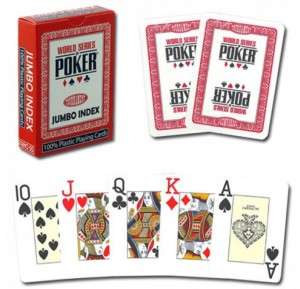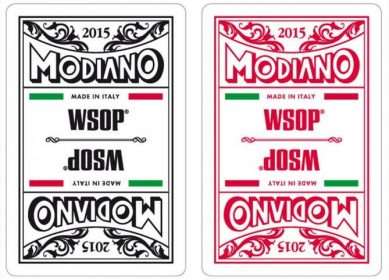New Modiano Cards Not Popular at WSOP
It’s always something at the World Series of Poker. No matter how hard the poker festival’s organizers try, no matter how long they work to get every detail down pat, something always gets screwed up, perturbing the players. And oftentimes, it is something that could have easily been avoided. Case in point: yet another card snafu.
The 2015 WSOP featured a new playing card manufacturer, the Italian company (whose offices and warehouse are in Indianaopolis, Indiana), Modiano. Modiano’s cards are plastic like most of the top-quality playing cards today – plastic is much more durable, as one might guess, than the typical paper-based cards most people in the world use – and Modiano says that its cards are “thicker and heavier” than any of its competitors’. This, as the company says, “enables Modiano cards to retain its character and shape better than other 100% plastic playing cards.”
According to many players, though, this claim is dubious, at best. Daniel Negreanu, in particular, has been quite outspoken with his opinions (shocker, I know), telling PokerNews.com, “There are several issues with the cards. The quality is too thin and they are easily marked. In the deuce-to-seven the other night, every three to four hands people were noticing marked cards, and they eventually just gave up, so they were essentially playing with marked cards.”
This criticism is particularly interesting in light of the recent cheating allegations against Valeriu Coca, one of the fifth place finishers in the $10,000 Heads-Up No Limit Hold’em tournament. Connor Drinan, who was eliminated from the competition by Coca in the second round, was the first to publicly accuse him of cheating, saying on Two Plus Two:
Pratyush Buddiga was the first to lose to him. He is my good friend but seemed pretty tilted so I didn’t ask details until I found out he was my next opponent. I asked for reads and whatnot and he basically told me he was really slow and passive in the beginning and then picked up the pace as the match went on as far as speed of play and aggression. He thought he was stalling in the beginning to give himself a better shot to win at a higher blind level. He said he would stall by rechecking his cards at a bunch of different angles when it was clear he made up his mind to fold already.
He did the same thing in my match. For the first 10 hands or so, he folded to most of my button opens and either limped or folded the button (doing the same obnoxious card checking tactics). I was thinking “man this guy is going to be a breeze.” From that point on I won very few pots the rest of the match. Every time I had a good starting hand he folded. If I had a bad one he raised or re-raised. If I whiffed a flop he attacked my c-bets. If I whiffed and went for a delayed cbet, he blasted turn into me every time. If I hit and bet, he folded. Hit and checked, he checked ect ect ect.
The upshot of all this is that Drinan and a few others who played against Coca believe he was somehow marking the cards, hence the stalling, checking cards from different angles, and his perfect reads. It was later revealed that Czech writer Martin Kuchařík had written a piece for a Czech poker news site that Coca had been kicked out of multiple Eastern European casinos for marking cards by bending them.
But wait, there’s more. Negreanu continued:
But the bigger problem is the way they manufactured them. The clubs and spades are similar in shape. A spade is usually pointy and has a rough edge. These ones are rounded, so it’s very difficult to tell them apart, especially if you don’t have great eyesight. And the face cards, especially in the stud games, if you’re sitting at the other end of the table, it’s very difficult to distinguish between a king, queen and a jack. These are all complaints that have been echoed by most people.
Some of those echoed complaints on Twitter:
“If Modiano’s goal was to make the clubs as close to the spades as possible, they nailed it @WSOP” – Andy Frankenberger
“the outlines of the clubs and spades are too similar. Easy to mix them up as spade edges are not sharp enough.” – Ryan LaPlante
“very hard to distinguish between spades and clubs on the flop.” – Matt Glantz
 Negreanu added on Twitter, “Modiano supplied the new cards for the WSOP and are the worst cards I’ve seen since the ones that had Jeffrey Pollack’s name on them!”
Negreanu added on Twitter, “Modiano supplied the new cards for the WSOP and are the worst cards I’ve seen since the ones that had Jeffrey Pollack’s name on them!”
And it goes on and on with more complaints from around the interwebs about the hard to read suits, difficult to differentiate face cards, and how thin and flimsy the cards are.
The reference Negreanu makes to Jeffrey Pollack’s cards hearkens back to 2007 when the United States Playing Card Company introduced a new “PokerPeek” card for the WSOP. Pollack was the WSOP commissioner at the time. The new style of card was created in direct response to complaints from the previous year, specifically that the cards were poor quality and were easy to damage (same as this year), the flop was difficult to read (hmm….), and the corner numbers were difficult to read, making it tough for less experienced players to peel their cards without exposing them to opponents.
The PokerPeek cards were made from high-quality KEM cards, so the physical sturdiness concern was solved. The solutions to the other problems, though, just created different ones. USPCC made the pips smaller and numbers larger so that the cards would be easier to read from everywhere at the table, but in turn, the Sixes and Nines became almost impossible to differentiate without serious examination. And to fix the corner number problem, those numbers were set at an angle. Makes sense, but what happened there was that the numbers then had to be made smaller and therefore people with less-than-stellar vision had trouble seeing them.
The cards were removed from the WSOP tournament tables fairly quickly and more acceptable cards were substituted.



















COMMENTS